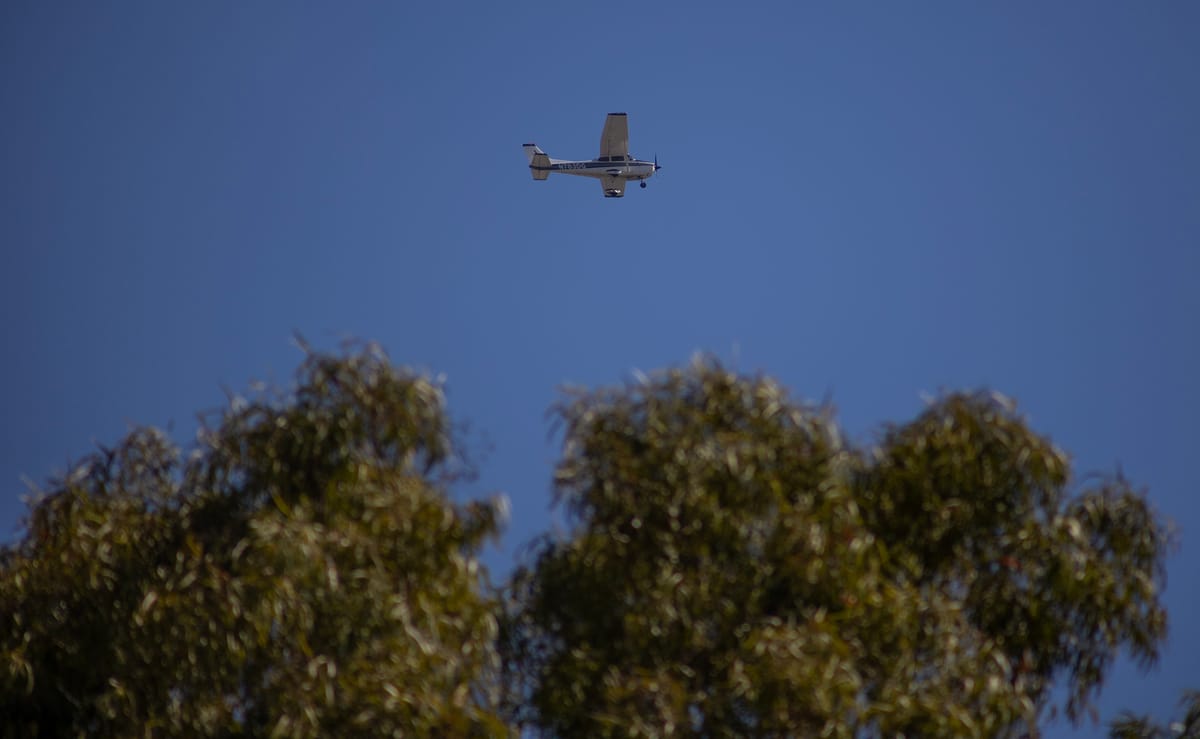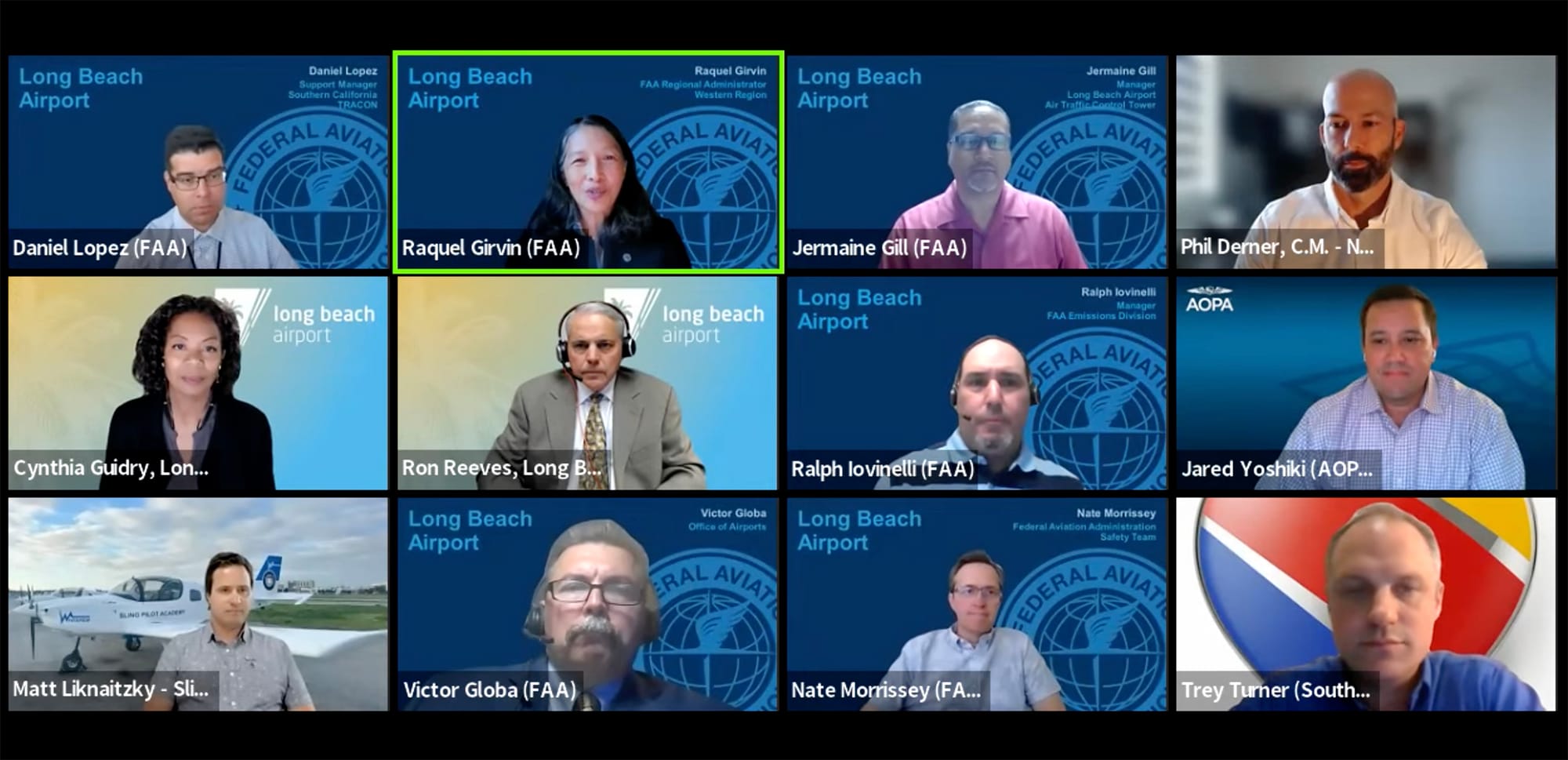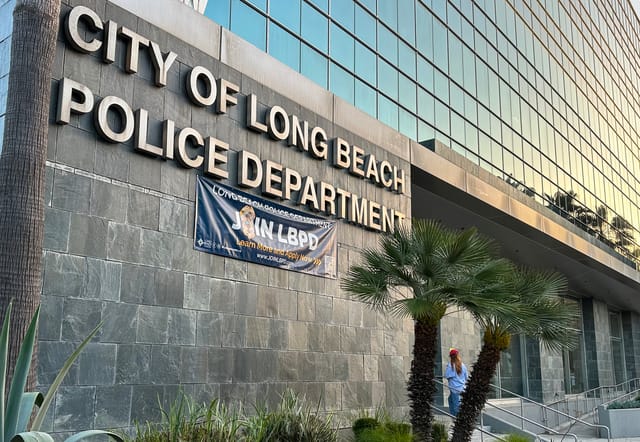‘A big middle finger to us’: Residents unimpressed with FAA, LGB informational webinar
Federal and local officials, as well as industry experts, answered dozens of community questions related to general aviation operations.

Residents angry over rising noise and air pollution resulting from general aviation operations out of Long Beach Airport said they were unsatisfied by answers given by federal and city staff during an informational webinar that included a Q&A.
“It was all a big middle finger to us,” Loren Fierman said in a comment on the Small Aircraft NoisE Reduction Facebook page following the meeting.
For about a year, SANeR has been pushing back against noise and pollution from small aircraft flying around the city, growing to nearly 850 members on the social media platform. The group took its activism to the next level last month when more than 120 gathered at the airport in protest.
Tuesday night’s webinar was announced just days before the protest.
“I have lived by Wardlow Park for 57 years — I have never heard so much noise or seen so many small, loud, planes,” Patricia Rowe said in the YouTube live chat during the webinar.
Data presented by airport staff tells a somewhat different story.
General aviation at Long Beach Airport peaked in 1999 with 475,000 operations, according to city data. By 2018, annual operations had dropped to 212,000.
But since 2018, general aviation has seen a dramatic uptick, rising 46% through 2023, which saw 310,000 operations, data shows. Industry leaders did not shy away from this fact.
“Flight training has increased across the country and there have been efforts at various airports to try to find a way to mitigate the additional noise created by airplanes,” said Matt Liknaitzky, co-CEO of Sling Pilot Academy, one of the leading flight schools in the region.
Brandon Richardson was laid off by the Long Beach Post on March 22. Thank him for continuing to cover Long Beach without pay.
Government officials and industry leaders said the increase can largely be attributed to the looming pilot shortage. According to analysts from consulting firms such as Oliver Wyman, the U.S. market is expected to have a shortage of nearly 30,000 pilots.
In addition to older pilots retiring (commercial airline pilots are mandated to retire at 65), FAA safety team member Nate Morrissey noted that, in the past, most pilots were trained in the military, which took the burden off of local airports and their surrounding neighborhoods.
“But today the majority of airline pilots train outside of the military at airports just like Long Beach,” Morrissey said. “The civilian training is helping ease the pilot shortage.”
One question brought up several times by residents during the webinar was why general aviation operations occur outside of certain time restrictions set by the airport’s noise ordinance, which restrict certain operations outside of 7 a.m. to 7 p.m. on weekdays and 8 a.m. to 3 p.m. on weekends.
Ron Reeves, operations and facilities bureau manager at LGB, explained that the airport is open 24/7 and that the noise ordinance only restricts certain training exercises such as “touch and goes” (when a plane lands briefly and then takes off again in one maneuver). Non-training operations are allowed anytime.
Reeves admitted that there is a loophole to the restriction, which could see pilots land, taxi off the runway and then take off again.
Attempting to close the loophole, Reeves said, could be detrimental to the airport’s noise ordinance, which also limits noisier commercial operations. The ordinance was grandfathered in after the passage of the Airport Noise and Capacity Act of 1990. Modifications to the ordinance could open it up to federal challenge and see it removed, clearing the way for additional flights.
But SANeR members were dissatisfied by the explanation, which they say is the same excuse they’ve heard for the past year.
“We were disappointed in tonight’s webinar,” SANeR members Lisa Dunn and Tara Dewitt Coomans said in a text message, noting that only a fraction of the hundreds of questions submitted were answered, many of which seemed repetitive. “This is really a David and Goliath situation.”

Residents questioned why airport staff are not enforcing the ordinance and punishing those who violate it. Reeves was adamant that airport staff works “very hard to catch each and every one of those violators.”
From January through April, airport staff have identified 39 general aviation noise violations, up 2.6% from the same period in 2023, according to city data. During that same time, there were 118,400 general aviation operations, up 20.4% from the same period last year.
A pilot’s first violation, Reeves explained, earns them a notice and a physical copy of the noise ordinance. After their second violation, pilots receive another notice, another copy of the ordinance and the requirement to submit a written noise compliance program explaining what they will do differently to avoid further violations.
Monetary fines ($100) do not begin until a pilot’s third violation, Reeves said. All subsequent violations will cost the pilot $300, he added.
Despite the relatively low number of noise violations, the airport received 52,771 noise complaints in April alone, city data shows. The vast majority — 42,072 — of complaints came from the 90807 zip code, which includes the Bixby Knolls, California Heights and Los Cerritos neighborhoods.
Another hot topic in question was the continued use of leaded fuel by general aviation planes. An unleaded fuel option compatible with about two-thirds of the small planes operating at Long Beach was introduced when Signature Aviation, Long Beach Airport’s leading fixed-base operator, ordered 992 gallons in September of last year.
But in the nine months since offering the unleaded fuel, Signature has yet to have to order more. During that same period, meanwhile, operators have ordered nearly 262,000 gallons of leaded fuel.
Similar to their inability to further regulate flight operations, officials said they are unable, at this time, to tell pilots what fuel to use, according to FAA Emissions Division Manager Ralph Iovinelli. But that will soon change, he said.
“Right now, the FAA is taking steps to start the rulemaking process this calendar year,” Iovinelli said, adding that the administration has new authority following an Environmental Protection Agency October report outlining the dangers of aviation lead emissions.
“We are not waiting,” he added. “We’re moving as fast as we can on this process.”
Even before the EPA determination, the FAA and industry leaders had established Eliminate Aviation Gasoline Lead Emissions, or EAGLE, to help phase out leaded aviation fuel by 2030.
“We want to be good partners, we want to be good neighbors,” said Phil Derner, the National Business Aviation Association’s western regional representative. “The industry is really dedicated to making this transition. We share the same air.”
While the city has taken steps to encourage pilots and flight schools to ease the impacts on the community, including fee waivers, subsidies and requests for participation in a voluntary “Fly Friendly” program, not all operators have gotten on board, airport Director Cynthia Guidry admitted Tuesday.
“It’s a process,” Guidry said. “It’s going to take a minute, but what I like to see is everyone’s at the table for the most part.”
But the needle is not moving fast enough for SANeR members.
“It’s disappointing,” Dunn and Dewitt Coomans said. “Long Beach can do better.”

We need your support.
Subcribe to the Watchdog today.
The Long Beach Watchdog is owned by journalists, and paid for by readers like you. If independent, local reporting like the story you just read is important to you, support our work by becoming a subscriber.






